Yuman vs Native/Alaskan Community Comparison
COMPARE
Yuman
Native/Alaskan
Social Comparison
Social Comparison
Yuman
Natives/Alaskans
959
SOCIAL INDEX
7.1/ 100
SOCIAL RATING
331st/ 347
SOCIAL RANK
1,140
SOCIAL INDEX
9.0/ 100
SOCIAL RATING
321st/ 347
SOCIAL RANK
Native/Alaskan Integration in Yuman Communities
The statistical analysis conducted on geographies consisting of 40,665,659 people shows a significant positive correlation between the proportion of Natives/Alaskans within Yuman communities in the United States with a correlation coefficient (R) of 0.631. On average, for every 1% (one percent) increase in Yuman within a typical geography, there is an increase of 0.741% in Natives/Alaskans. To illustrate, in a geography comprising of 100,000 individuals, a rise of 1,000 Yuman corresponds to an increase of 741.3 Natives/Alaskans.
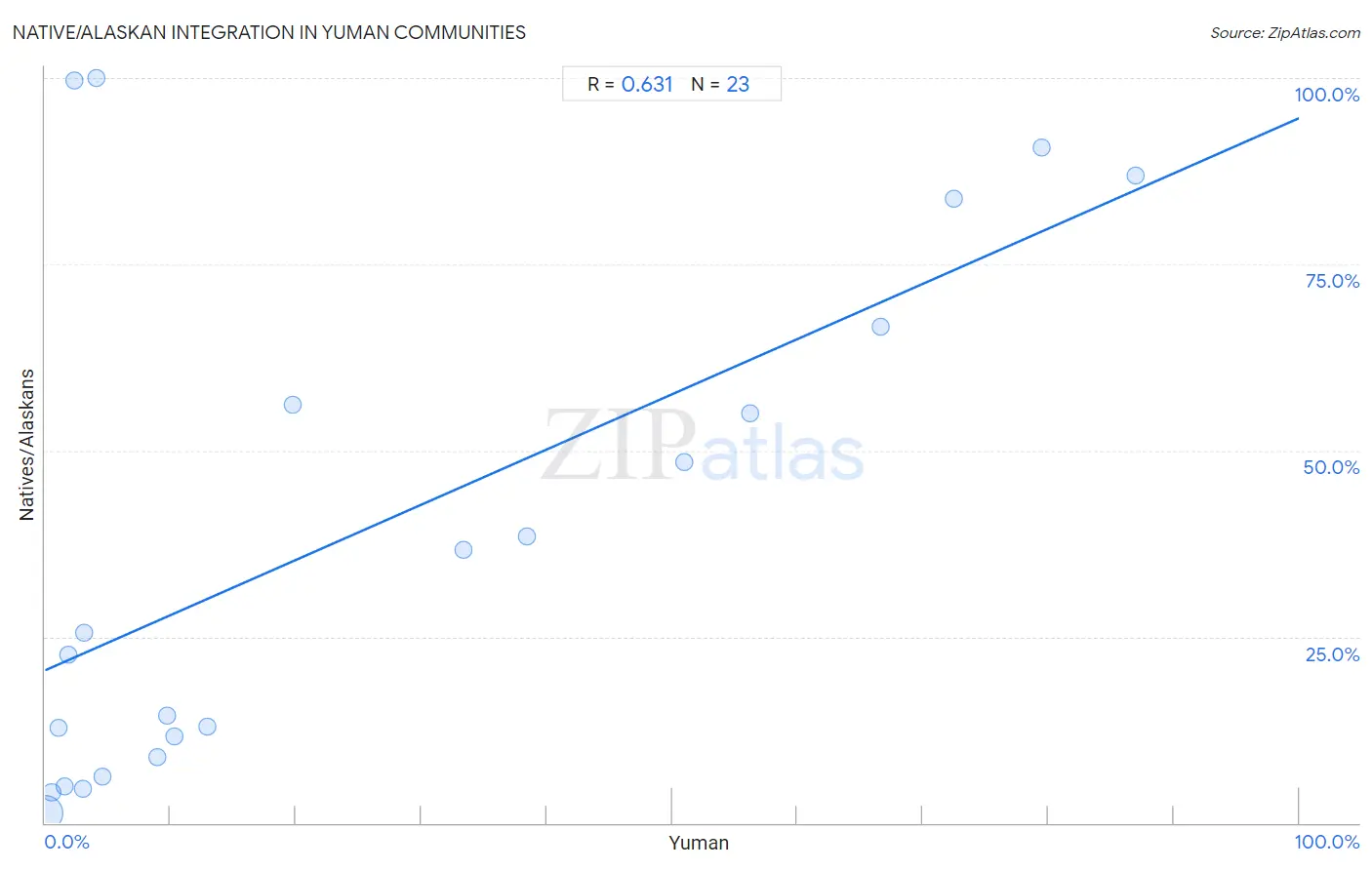
Yuman vs Native/Alaskan Income
When considering income, the most significant differences between Yuman and Native/Alaskan communities in the United States are seen in householder income under 25 years ($50,933 compared to $47,704, a difference of 6.8%), wage/income gap (23.3% compared to 24.6%, a difference of 5.3%), and median female earnings ($35,377 compared to $33,806, a difference of 4.6%). Conversely, both communities are more comparable in terms of per capita income ($33,236 compared to $33,279, a difference of 0.13%), median household income ($68,743 compared to $67,879, a difference of 1.3%), and median male earnings ($45,446 compared to $44,775, a difference of 1.5%).

| Income Metric | Yuman | Native/Alaskan |
| Per Capita Income | Tragic $33,236 | Tragic $33,279 |
| Median Family Income | Tragic $78,055 | Tragic $80,908 |
| Median Household Income | Tragic $68,743 | Tragic $67,879 |
| Median Earnings | Tragic $39,523 | Tragic $38,896 |
| Median Male Earnings | Tragic $45,446 | Tragic $44,775 |
| Median Female Earnings | Tragic $35,377 | Tragic $33,806 |
| Householder Age | Under 25 years | Tragic $50,933 | Tragic $47,704 |
| Householder Age | 25 - 44 years | Tragic $72,956 | Tragic $75,647 |
| Householder Age | 45 - 64 years | Tragic $82,139 | Tragic $79,816 |
| Householder Age | Over 65 years | Tragic $53,110 | Tragic $52,081 |
| Wage/Income Gap | Exceptional 23.3% | Exceptional 24.6% |
Yuman vs Native/Alaskan Poverty
When considering poverty, the most significant differences between Yuman and Native/Alaskan communities in the United States are seen in child poverty among boys under 16 (30.6% compared to 24.0%, a difference of 27.9%), single father poverty (28.4% compared to 22.4%, a difference of 26.8%), and child poverty under the age of 16 (28.9% compared to 23.8%, a difference of 21.7%). Conversely, both communities are more comparable in terms of seniors poverty over the age of 75 (15.4% compared to 15.5%, a difference of 0.62%), single mother poverty (37.8% compared to 36.6%, a difference of 3.1%), and single female poverty (29.4% compared to 28.2%, a difference of 4.3%).
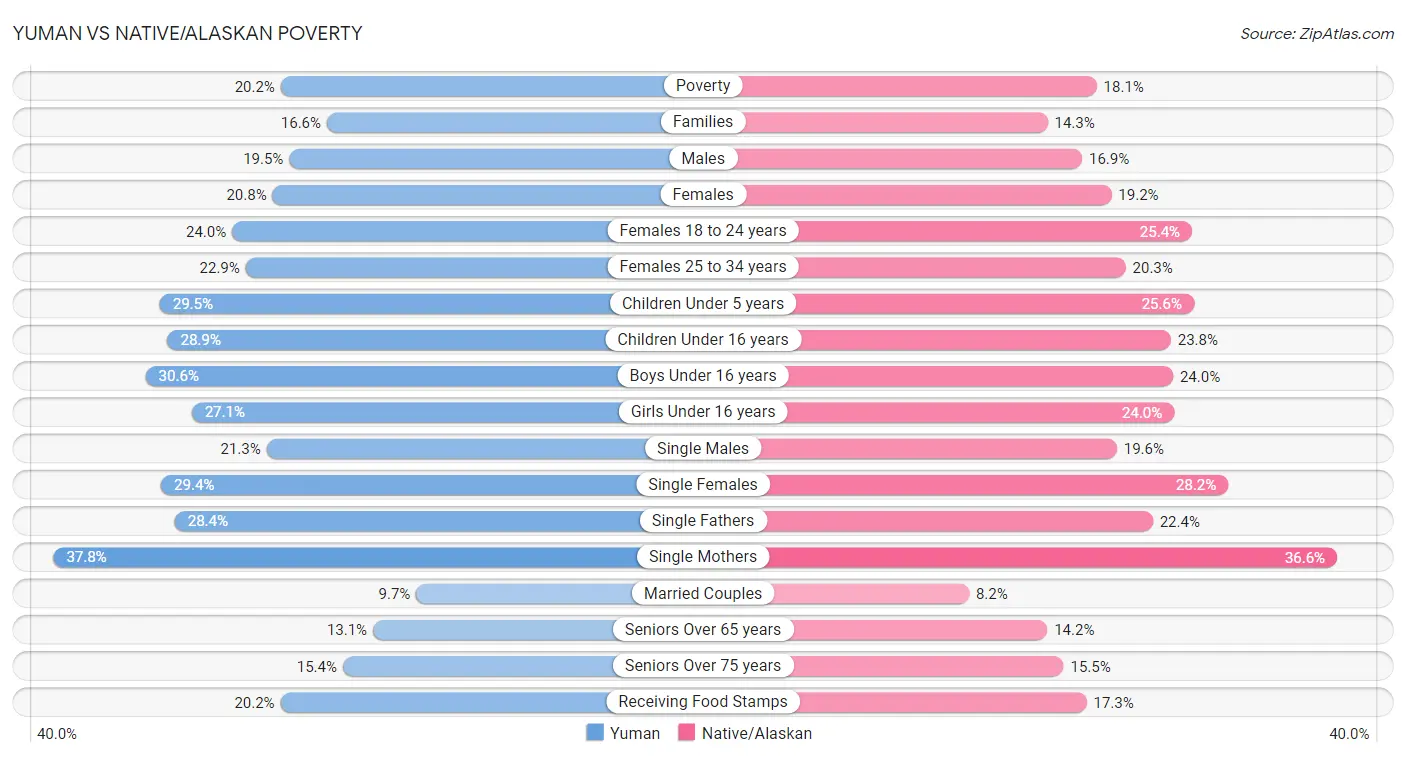
| Poverty Metric | Yuman | Native/Alaskan |
| Poverty | Tragic 20.2% | Tragic 18.1% |
| Families | Tragic 16.6% | Tragic 14.3% |
| Males | Tragic 19.5% | Tragic 16.9% |
| Females | Tragic 20.8% | Tragic 19.2% |
| Females 18 to 24 years | Tragic 24.0% | Tragic 25.4% |
| Females 25 to 34 years | Tragic 22.9% | Tragic 20.3% |
| Children Under 5 years | Tragic 29.5% | Tragic 25.6% |
| Children Under 16 years | Tragic 28.9% | Tragic 23.8% |
| Boys Under 16 years | Tragic 30.6% | Tragic 24.0% |
| Girls Under 16 years | Tragic 27.1% | Tragic 24.0% |
| Single Males | Tragic 21.3% | Tragic 19.6% |
| Single Females | Tragic 29.4% | Tragic 28.2% |
| Single Fathers | Tragic 28.4% | Tragic 22.4% |
| Single Mothers | Tragic 37.8% | Tragic 36.6% |
| Married Couples | Tragic 9.7% | Tragic 8.2% |
| Seniors Over 65 years | Tragic 13.1% | Tragic 14.2% |
| Seniors Over 75 years | Tragic 15.4% | Tragic 15.5% |
| Receiving Food Stamps | Tragic 20.2% | Tragic 17.3% |
Yuman vs Native/Alaskan Unemployment
When considering unemployment, the most significant differences between Yuman and Native/Alaskan communities in the United States are seen in unemployment among ages 35 to 44 years (16.9% compared to 7.3%, a difference of 133.2%), unemployment among ages 16 to 19 years (37.4% compared to 21.5%, a difference of 74.0%), and unemployment among ages 45 to 54 years (9.5% compared to 6.1%, a difference of 56.8%). Conversely, both communities are more comparable in terms of unemployment among seniors over 65 years (5.8% compared to 5.8%, a difference of 0.51%), unemployment among ages 55 to 59 years (6.1% compared to 6.0%, a difference of 2.1%), and unemployment among ages 65 to 74 years (6.2% compared to 6.0%, a difference of 3.4%).
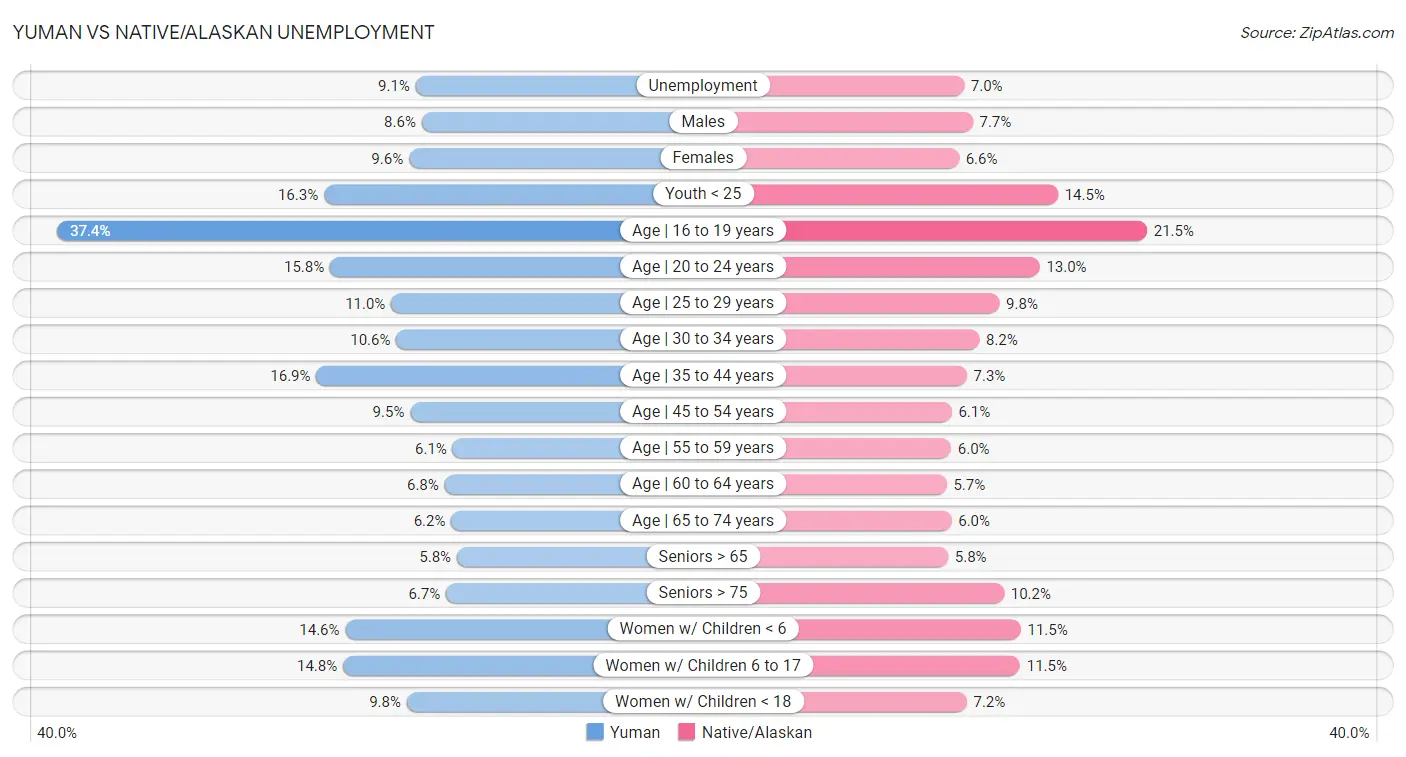
| Unemployment Metric | Yuman | Native/Alaskan |
| Unemployment | Tragic 9.1% | Tragic 7.0% |
| Males | Tragic 8.6% | Tragic 7.7% |
| Females | Tragic 9.6% | Tragic 6.6% |
| Youth < 25 | Tragic 16.3% | Tragic 14.5% |
| Age | 16 to 19 years | Tragic 37.4% | Tragic 21.5% |
| Age | 20 to 24 years | Tragic 15.8% | Tragic 13.0% |
| Age | 25 to 29 years | Tragic 11.0% | Tragic 9.8% |
| Age | 30 to 34 years | Tragic 10.6% | Tragic 8.2% |
| Age | 35 to 44 years | Tragic 16.9% | Tragic 7.3% |
| Age | 45 to 54 years | Tragic 9.5% | Tragic 6.1% |
| Age | 55 to 59 years | Tragic 6.1% | Tragic 6.0% |
| Age | 60 to 64 years | Tragic 6.8% | Tragic 5.7% |
| Age | 65 to 74 years | Tragic 6.2% | Tragic 6.0% |
| Seniors > 65 | Tragic 5.8% | Tragic 5.8% |
| Seniors > 75 | Exceptional 6.7% | Tragic 10.2% |
| Women w/ Children < 6 | Tragic 14.6% | Tragic 11.5% |
| Women w/ Children 6 to 17 | Tragic 14.8% | Tragic 11.5% |
| Women w/ Children < 18 | Tragic 9.8% | Tragic 7.2% |
Yuman vs Native/Alaskan Labor Participation
When considering labor participation, the most significant differences between Yuman and Native/Alaskan communities in the United States are seen in in labor force | age 16-19 (27.7% compared to 36.6%, a difference of 32.2%), in labor force | age 35-44 (74.7% compared to 78.9%, a difference of 5.5%), and in labor force | age > 16 (57.8% compared to 60.6%, a difference of 4.8%). Conversely, both communities are more comparable in terms of in labor force | age 25-29 (79.3% compared to 79.3%, a difference of 0.080%), in labor force | age 45-54 (76.3% compared to 77.1%, a difference of 1.1%), and in labor force | age 30-34 (77.1% compared to 79.2%, a difference of 2.7%).

| Labor Participation Metric | Yuman | Native/Alaskan |
| In Labor Force | Age > 16 | Tragic 57.8% | Tragic 60.6% |
| In Labor Force | Age 20-64 | Tragic 71.7% | Tragic 73.9% |
| In Labor Force | Age 16-19 | Tragic 27.7% | Average 36.6% |
| In Labor Force | Age 20-24 | Tragic 70.3% | Tragic 72.4% |
| In Labor Force | Age 25-29 | Tragic 79.3% | Tragic 79.3% |
| In Labor Force | Age 30-34 | Tragic 77.1% | Tragic 79.2% |
| In Labor Force | Age 35-44 | Tragic 74.7% | Tragic 78.9% |
| In Labor Force | Age 45-54 | Tragic 76.3% | Tragic 77.1% |
Yuman vs Native/Alaskan Family Structure
When considering family structure, the most significant differences between Yuman and Native/Alaskan communities in the United States are seen in single mother households (9.6% compared to 8.0%, a difference of 20.1%), family households (69.3% compared to 66.4%, a difference of 4.4%), and family households with children (29.5% compared to 28.4%, a difference of 3.8%). Conversely, both communities are more comparable in terms of married-couple households (43.3% compared to 43.5%, a difference of 0.36%), average family size (3.47 compared to 3.45, a difference of 0.47%), and currently married (42.6% compared to 42.8%, a difference of 0.54%).

| Family Structure Metric | Yuman | Native/Alaskan |
| Family Households | Exceptional 69.3% | Exceptional 66.4% |
| Family Households with Children | Exceptional 29.5% | Exceptional 28.4% |
| Married-couple Households | Tragic 43.3% | Tragic 43.5% |
| Average Family Size | Exceptional 3.47 | Exceptional 3.45 |
| Single Father Households | Tragic 3.3% | Tragic 3.2% |
| Single Mother Households | Tragic 9.6% | Tragic 8.0% |
| Currently Married | Tragic 42.6% | Tragic 42.8% |
| Divorced or Separated | Tragic 12.6% | Tragic 13.0% |
| Births to Unmarried Women | Tragic 44.4% | Tragic 43.0% |
Yuman vs Native/Alaskan Vehicle Availability
When considering vehicle availability, the most significant differences between Yuman and Native/Alaskan communities in the United States are seen in no vehicles in household (14.9% compared to 10.5%, a difference of 41.5%), 4 or more vehicles in household (6.5% compared to 8.2%, a difference of 26.4%), and 3 or more vehicles in household (19.9% compared to 22.7%, a difference of 14.2%). Conversely, both communities are more comparable in terms of 1 or more vehicles in household (85.5% compared to 89.8%, a difference of 5.1%), 2 or more vehicles in household (51.7% compared to 57.0%, a difference of 10.1%), and 3 or more vehicles in household (19.9% compared to 22.7%, a difference of 14.2%).

| Vehicle Availability Metric | Yuman | Native/Alaskan |
| No Vehicles Available | Tragic 14.9% | Average 10.5% |
| 1+ Vehicles Available | Tragic 85.5% | Average 89.8% |
| 2+ Vehicles Available | Tragic 51.7% | Exceptional 57.0% |
| 3+ Vehicles Available | Good 19.9% | Exceptional 22.7% |
| 4+ Vehicles Available | Good 6.5% | Exceptional 8.2% |
Yuman vs Native/Alaskan Education Level
When considering education level, the most significant differences between Yuman and Native/Alaskan communities in the United States are seen in doctorate degree (1.5% compared to 1.3%, a difference of 15.8%), associate's degree (31.3% compared to 34.9%, a difference of 11.7%), and professional degree (3.3% compared to 3.0%, a difference of 10.7%). Conversely, both communities are more comparable in terms of nursery school (97.9% compared to 98.0%, a difference of 0.080%), 1st grade (97.8% compared to 97.9%, a difference of 0.090%), and 2nd grade (97.8% compared to 97.9%, a difference of 0.090%).
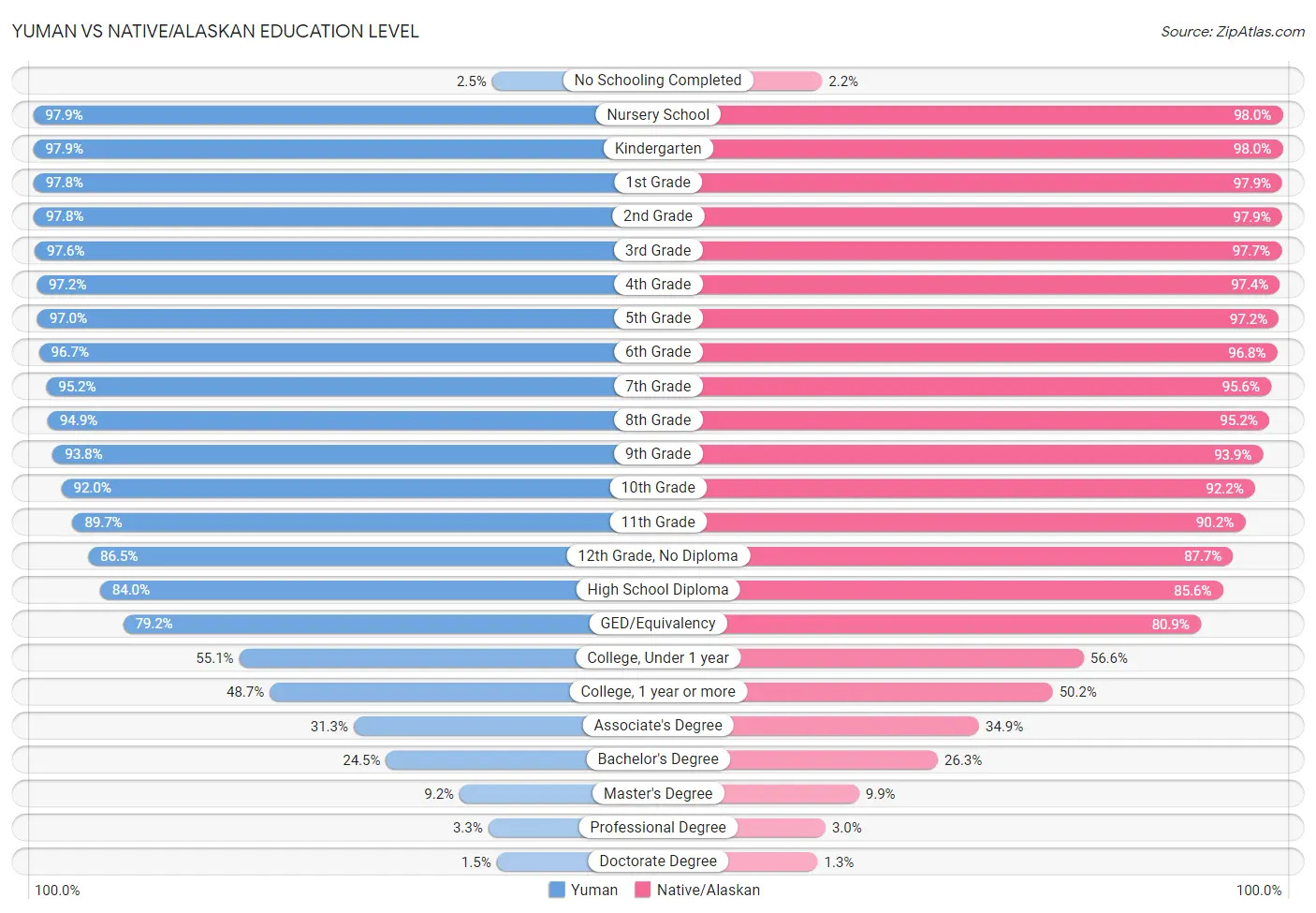
| Education Level Metric | Yuman | Native/Alaskan |
| No Schooling Completed | Tragic 2.5% | Tragic 2.2% |
| Nursery School | Fair 97.9% | Average 98.0% |
| Kindergarten | Fair 97.9% | Average 98.0% |
| 1st Grade | Fair 97.8% | Average 97.9% |
| 2nd Grade | Fair 97.8% | Average 97.9% |
| 3rd Grade | Tragic 97.6% | Fair 97.7% |
| 4th Grade | Tragic 97.2% | Fair 97.4% |
| 5th Grade | Tragic 97.0% | Poor 97.2% |
| 6th Grade | Tragic 96.7% | Poor 96.8% |
| 7th Grade | Tragic 95.2% | Tragic 95.6% |
| 8th Grade | Tragic 94.9% | Tragic 95.2% |
| 9th Grade | Tragic 93.8% | Tragic 93.9% |
| 10th Grade | Tragic 92.0% | Tragic 92.2% |
| 11th Grade | Tragic 89.7% | Tragic 90.2% |
| 12th Grade, No Diploma | Tragic 86.5% | Tragic 87.7% |
| High School Diploma | Tragic 84.0% | Tragic 85.6% |
| GED/Equivalency | Tragic 79.2% | Tragic 80.9% |
| College, Under 1 year | Tragic 55.1% | Tragic 56.6% |
| College, 1 year or more | Tragic 48.7% | Tragic 50.2% |
| Associate's Degree | Tragic 31.3% | Tragic 34.9% |
| Bachelor's Degree | Tragic 24.5% | Tragic 26.3% |
| Master's Degree | Tragic 9.2% | Tragic 9.9% |
| Professional Degree | Tragic 3.3% | Tragic 3.0% |
| Doctorate Degree | Tragic 1.5% | Tragic 1.3% |
Yuman vs Native/Alaskan Disability
When considering disability, the most significant differences between Yuman and Native/Alaskan communities in the United States are seen in disability age under 5 (0.95% compared to 1.9%, a difference of 105.3%), disability age 18 to 34 (10.6% compared to 8.2%, a difference of 28.5%), and hearing disability (3.4% compared to 4.2%, a difference of 24.3%). Conversely, both communities are more comparable in terms of cognitive disability (18.1% compared to 18.1%, a difference of 0.39%), vision disability (3.0% compared to 3.0%, a difference of 0.54%), and female disability (14.5% compared to 14.1%, a difference of 2.5%).
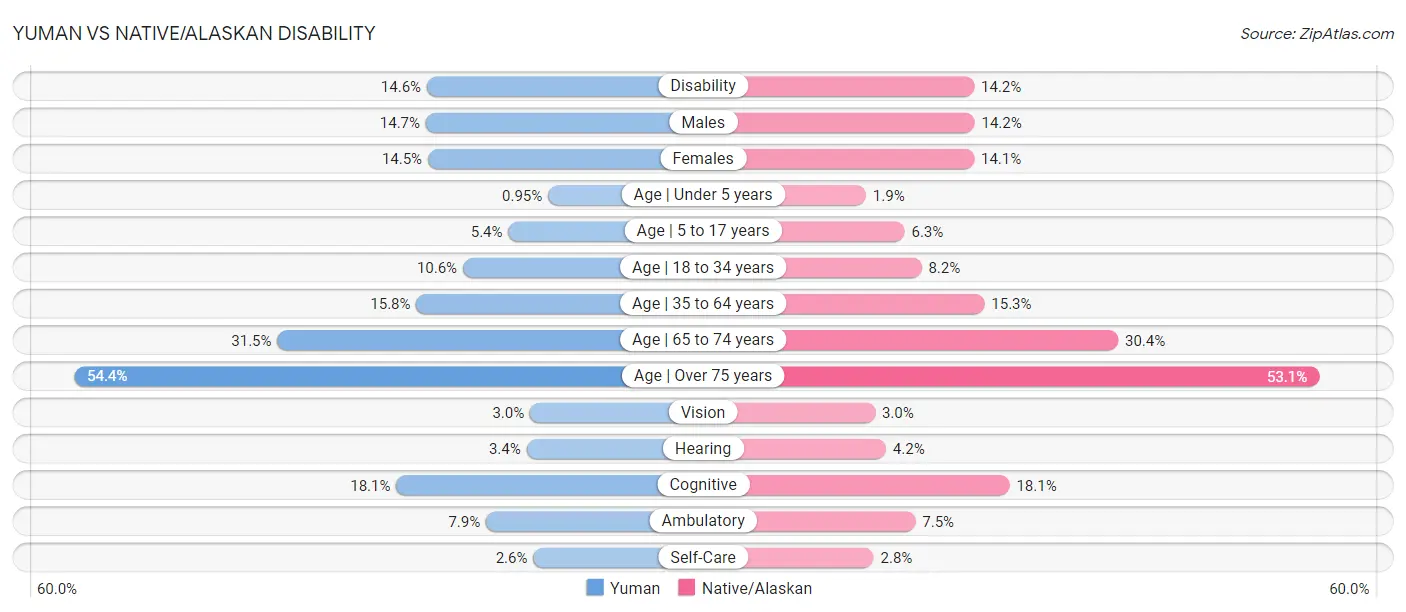
| Disability Metric | Yuman | Native/Alaskan |
| Disability | Tragic 14.6% | Tragic 14.2% |
| Males | Tragic 14.7% | Tragic 14.2% |
| Females | Tragic 14.5% | Tragic 14.1% |
| Age | Under 5 years | Exceptional 0.95% | Tragic 1.9% |
| Age | 5 to 17 years | Exceptional 5.4% | Tragic 6.3% |
| Age | 18 to 34 years | Tragic 10.6% | Tragic 8.2% |
| Age | 35 to 64 years | Tragic 15.8% | Tragic 15.3% |
| Age | 65 to 74 years | Tragic 31.5% | Tragic 30.4% |
| Age | Over 75 years | Tragic 54.4% | Tragic 53.1% |
| Vision | Tragic 3.0% | Tragic 3.0% |
| Hearing | Tragic 3.4% | Tragic 4.2% |
| Cognitive | Tragic 18.1% | Tragic 18.1% |
| Ambulatory | Tragic 7.9% | Tragic 7.5% |
| Self-Care | Tragic 2.6% | Tragic 2.8% |